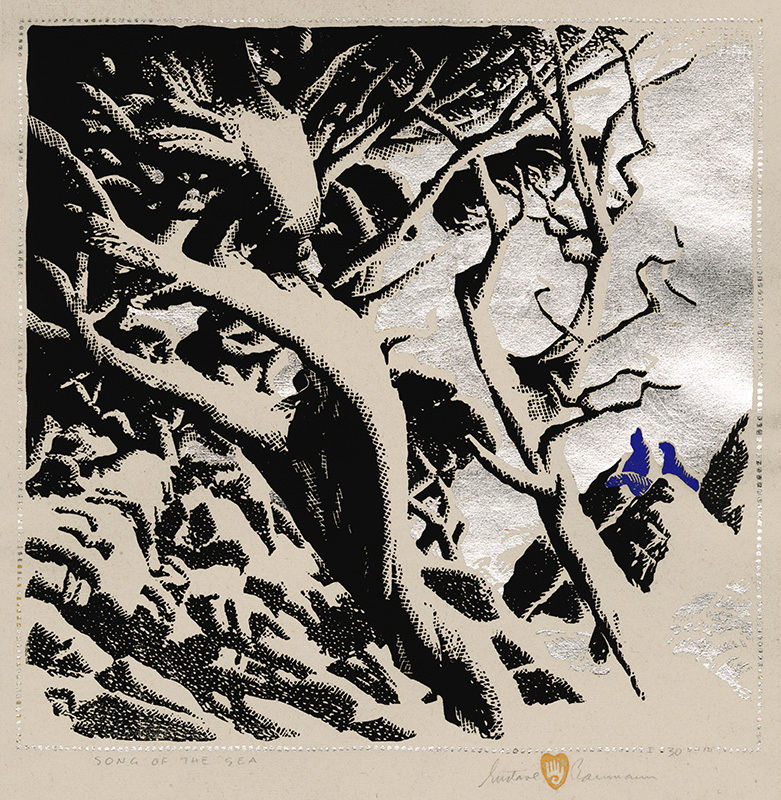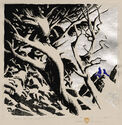
19th, 20th & 21st Century Fine Prints
707-546-7352 · fax 707-546-7924 · web: www.annexgalleries.com · email: artannex@aol.com
Song of the Sea by Gustave Baumann



Song of the Sea
Gustave Baumann
Song of the Sea
Gustave Baumann
1881 - 1971 (biography)Song of the Sea is one of fourteen color woodcuts in which Baumann employed metal leaf as a color. The locale is the Monterey coast of California and the tempera studies for Point Lobos, Monterey Cypress, and Pacific Shoreline were probably completed during Baumann's auto trip up the California coastline in 1934. For Song of the Sea, Baumann revisited his tempera for Monterey Cypress. He reversed his design, simplified the pictorial elements, relied on negative space to create the dramatic structure of the cypress trees and rocks, used aluminum leaf as the color for the background, and added blue sea lions to the rock outcropping to give voice to his new color woodcut.
Gustave Baumann was born in Magdeburg, Germany on 27 June 1881. Ten years later his family immigrated to the US, settling in Chicago. In 1896, Baumann began working in the commercial art field while saving money to study in Germany. After returning from Munich in December 1905 where he studied at the Kunstgewerbeschule, Baumann worked again in commercial art to support his family. In 1909, he discovered Brown County, Indiana where life was inexpensive and he could stay for three months. He produced a series of small format color woodcuts featuring the people and places of Brown County and then produced five large format color woodcuts. His woodcuts were accepted by the committee for the 1915 Panama Pacific International Exposition and he won a gold medal. In 1916. Baumann headed east to Wyoming, New York in 1917 and taught at a summer school. From there he headed to Provincetown, Massachusetts and New York City before returning to set up his studio in Wyoming.
Many of his Chicago artist buddies had traveled to the southwest and Baumann became intrigued by their paintings and their souvenirs. They regaled him with their stories of an exotic place named Taos, New Mexico. Baumann spent the summer of 1918 in Taos sketching and painting before visiting Santa Fe. His funds were low and he needed to head back to Chicago but first stopped at the new art museum in Santa Fe to see an exhibition of his woodcuts. Paul Walter, the director of the Museum of New Mexico, offered him a studio in the basement of the museum. His wanderlust was satisfied as apart from numerous sketching trips over the years he remained in Santa Fe until his death on October 8, 1971.
During his ninety years, Baumann produced woodcuts, paintings, furniture, sculpture, toys and marionettes and wrote poetry and plays. Baumann was the ultimate craftsman, as he loved the feel of the wood, the tool and the handmade paper he selected. His hands controlled every aspect of his craft: the carving of the blocks, the mixing of the inks and the printing of the blocks.
Exhibitions of Baumann's color woodcuts circulated throughout the country in large part due to the American Federation of the Arts and the National Association of Women's Clubs. He also exhibited with the New Mexico Painters, the International Print Makers, Painters and Sculptors of the Southwest, and the Hoosier Salons. Solo exhibitions of Baumann's color woodcuts were mounted in museums and libraries across the United States and his work was represented in galleries from Carmel, California to New York City.



